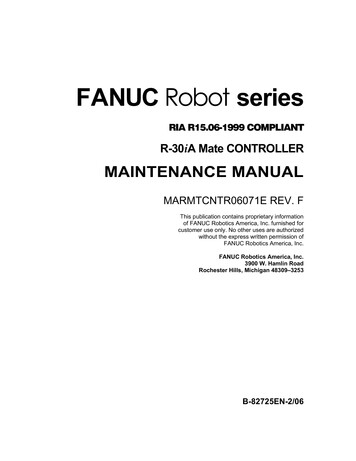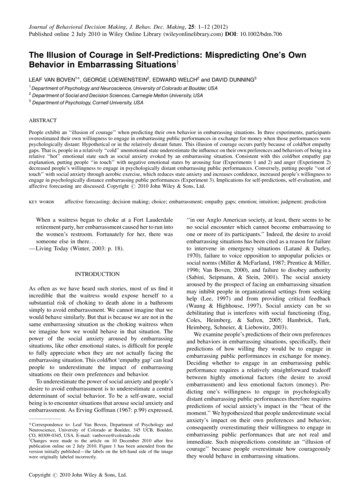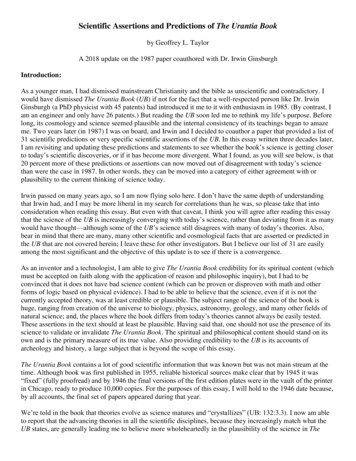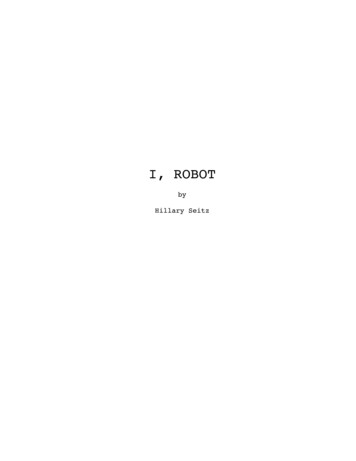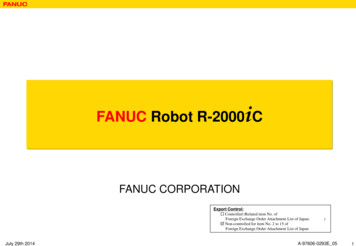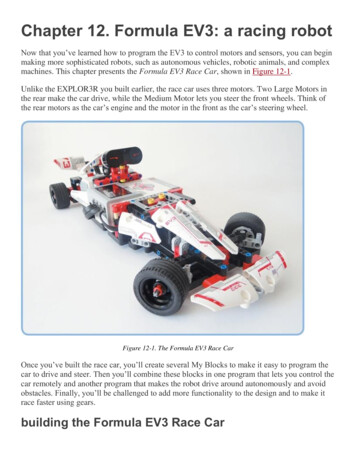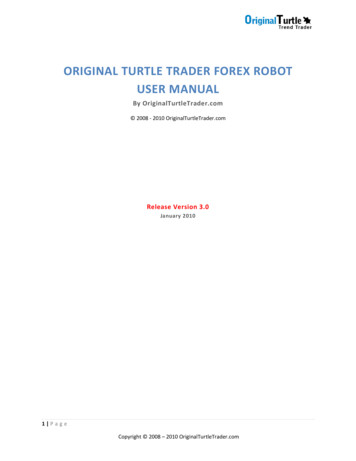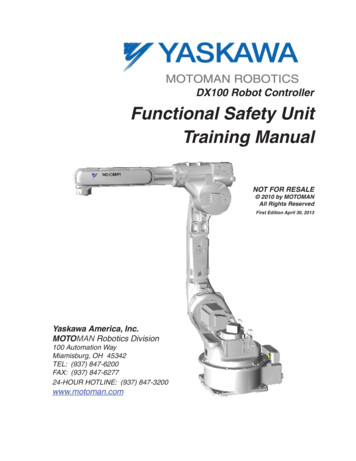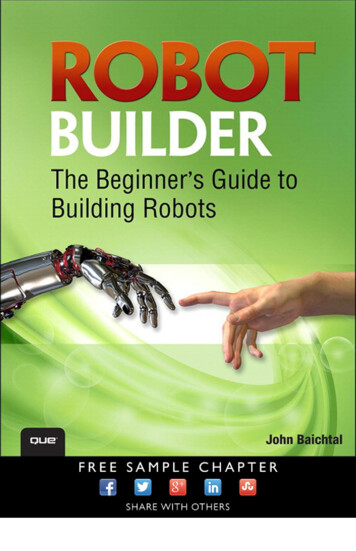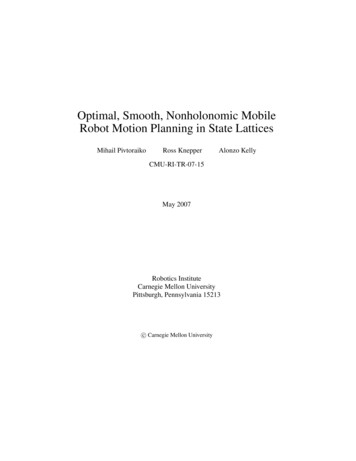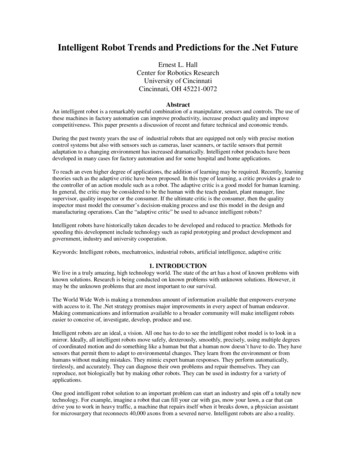
Transcription
Intelligent Robot Trends and Predictions for the .Net FutureErnest L. HallCenter for Robotics ResearchUniversity of CincinnatiCincinnati, OH 45221-0072AbstractAn intelligent robot is a remarkably useful combination of a manipulator, sensors and controls. The use ofthese machines in factory automation can improve productivity, increase product quality and improvecompetitiveness. This paper presents a discussion of recent and future technical and economic trends.During the past twenty years the use of industrial robots that are equipped not only with precise motioncontrol systems but also with sensors such as cameras, laser scanners, or tactile sensors that permitadaptation to a changing environment has increased dramatically. Intelligent robot products have beendeveloped in many cases for factory automation and for some hospital and home applications.To reach an even higher degree of applications, the addition of learning may be required. Recently, learningtheories such as the adaptive critic have been proposed. In this type of learning, a critic provides a grade tothe controller of an action module such as a robot. The adaptive critic is a good model for human learning.In general, the critic may be considered to be the human with the teach pendant, plant manager, linesupervisor, quality inspector or the consumer. If the ultimate critic is the consumer, then the qualityinspector must model the consumer’s decision-making process and use this model in the design andmanufacturing operations. Can the “adaptive critic” be used to advance intelligent robots?Intelligent robots have historically taken decades to be developed and reduced to practice. Methods forspeeding this development include technology such as rapid prototyping and product development andgovernment, industry and university cooperation.Keywords: Intelligent robots, mechatronics, industrial robots, artificial intelligence, adaptive critic1. INTRODUCTIONWe live in a truly amazing, high technology world. The state of the art has a host of known problems withknown solutions. Research is being conducted on known problems with unknown solutions. However, itmay be the unknown problems that are most important to our survival.The World Wide Web is making a tremendous amount of information available that empowers everyonewith access to it. The .Net strategy promises major improvements in every aspect of human endeavor.Making communications and information available to a broader community will make intelligent robotseasier to conceive of, investigate, develop, produce and use.Intelligent robots are an ideal, a vision. All one has to do to see the intelligent robot model is to look in amirror. Ideally, all intelligent robots move safely, dexterously, smoothly, precisely, using multiple degreesof coordinated motion and do something like a human but that a human now doesn’t have to do. They havesensors that permit them to adapt to environmental changes. They learn from the environment or fromhumans without making mistakes. They mimic expert human responses. They perform automatically,tirelessly, and accurately. They can diagnose their own problems and repair themselves. They canreproduce, not biologically but by making other robots. They can be used in industry for a variety ofapplications.One good intelligent robot solution to an important problem can start an industry and spin off a totally newtechnology. For example, imagine a robot that can fill your car with gas, mow your lawn, a car that candrive you to work in heavy traffic, a machine that repairs itself when it breaks down, a physician assistantfor microsurgery that reconnects 40,000 axons from a severed nerve. Intelligent robots are also a reality.
Many are used today. Many more prototypes have been built. Typical applications are high speed spotwelding, precise seam welding, spray painting robots that can move around the contours of an automobilebody, palletizing of variable size parcels, and loading and unloading machines.The Advisory Board of Robotics International of the Society of Manufacturing Engineers has produced anexcellent and practical trends report1. They address the trends in: PC based controllers for robots andcontrollers; easier to use systems; increased use of smart sensors; demand for special purpose robot models;increased information flow; and easier to deploy systems.This paper address intelligent robot trends in a broader and more theoretical manner. The paper isorganized as follows. In Section 2, some background in artificial intelligence and intelligent robots will bepresented. In Section 3, economic aspects will be presented. In Section 4, some topics of mechatronics willbe reviewed. In Section 5, an example of a new intelligent robot – TUT 1 is presented. In Section 6, theadaptive critic and its potential for making intelligent robots learn is examined. Finally, conclusions andpredictions are given in Section 6.1 Email:Ernie.Hall@uc.edu : WWW: http://ww.eng.uc.edu/robotics2. INTELLIGENT ROBOTSThe components of an intelligent robot are a manipulator, sensors and controls. However, it is the designarchitecture or the combination of these components, the paradigms programmed into the controller, theforesight and genius of the system marketing experts and designers, the practicality of the prototypebuilders, the professionalism and attention to quality of the manufacturing engineers and technicians thatmake the machine intelligent and useful.Just where is the intelligence in an intelligent robot? Is it in the design architecture, the controller or thecontent? It is in the controller just as the intelligence of a human is in the neural connections of the brain.However, it is only possible to see this intelligence through some action just as it would not be possible tosee intelligence in a comatose human. Where does the intelligence come from? The control program andarchitecture provide for real time responses to a variety of situations. If these responses are intelligent, thenthe robot appears intelligent. The answer to this question is still being debated. When are intelligent robotsneeded? When a task is repetitive such as making a million parts per year, automation is needed. The mostsuitable automation may be an intelligent robot. In addition, when a task is hazardous for humans,automation is needed. The best solution may be an intelligent remote manipulator. Finally, when anindustry needs to be internationally competitive in cost and quality, automation is needed. Again, theintelligent robot may play a significant part in the solution.What are the benefits from using intelligent robots? Robots can do many tasks now. However, the tasks thatcannot be easily done today are often characterized by a variable knowledge of the environment. Location,size, orientation, shape of the workpiece as well as of the robot must be known accurately to perform atask. Obstacles in the motion path, unusual events, breakage of tools, also create environmental uncertainty.Greater use of sensors and more intelligence should lead to a reduction of this uncertainty and because themachines can work 24 hours a day, should also lead to higher productivity. More intelligence could alsolead to faster, easier setups and reduced cycle times. More intelligence should also lead to fasterdiagnosis of problems and better maintenance for the systems. Finally, there is the fact that to remaininternationally competitive, the best technology usage is required. Waste of human or material resources istoo expensive for industry and for society. It is said that as manufacturing goes so does the quality of life.Since this paper is basically about factory automation, which may not be obviously considered hightechnology, let us begin with a few definitions. Intelligence is the most outstanding human characteristic;however, it is still not totally understood and therefore has many varying definitions, implied meanings,and levels of sophistication. Human intelligence is defined in Webster’s dictionary several ways. Considerthe two following.
1. The capacity to acquire and apply knowledge. This capacity may lead to the ability to learn orunderstand or to deal with new or trying situations.2. The faculty of thought and reason. This faculty may lead to the ability to apply knowledge to manipulateone’s environment.Studies in Artificial Intelligence (AI) attempt to implement the first definition of learning or understandingusually with a mathematical or computer algorithm. Research in Machine Intelligence (MI) is directedtoward designing new, useful, adaptive machines. Some of the goals of AI are: Finding new methods for extracting useful information from the environment using sensors. Developing methods for building, updating, mining and retaining information from a knowledge base. Inventing algorithms for utilizing information stored in a knowledge base to make intelligent decisions. Finding improved methods for translating user needs into a workable software system. Developing reusable software components that can expand toward an ultimate software system.Why all the emphasis on computers and AI if we are talking about mechanical robots? Genetic engineeringaside, it is only with computer control that we have any possibility of building an intelligent robot. Anycomparison of the complexities of a human arm and a manipulator arm show how little we still know aboutarms. The best prosthetics today are poor substitutes for the originals. Also, designing a robot requires theuse of many computer tools such as symbolic computation of nonlinear inverse kinematic and dynamicequations, simulation of control characteristics, simulation of manipulator motions and interactions, pathplanning, obstacle avoidance, self diagnosis, self repair, etc. Robot intelligence implies doing something inthe real world and is often taken as the ability of a robot to adapt to changes in its environment, andpossibly to learn from these adaptations. Intelligence is a difficult characteristic to guarantee in eitherhumans or machines and is not mentioned in either the industry or standard definition. Intelligence cannotbe easily measured. Only in science fiction does one try to defend a robot gone awry as lackingintelligence. In our world, the designers, manufacturers and users must answer and often pay dearly fordesign mistakes and manufacturing flaws.The Robotics Industries Association (RIA) definition of an industrial robot is: “a reprogrammablemultifunctional machine designed to manipulate materials, parts, tools, or specialized devices, throughvariable programmed motions for the performance of a variety of tasks.”The definition according to the International Standard ISO 8373:1994(E/F) for a manipulating industrialrobot is: “An automatically controlled, reprogrammable multi-purpose manipulator programmable in threeor more axes, which may be either fixed to place or mobile for use in industrial automation applications.Perhaps “multifunctional” is the most difficult aspect to achieve. One risks doing many things poorly ratherthan one thing outstandingly. Humans also face this choice of specialty or generality in their careers.1.1 MissionThe mission of intelligent robotics theory and practice is to: produce intelligent robots to serve mankind encourage the developmental transitions of intelligent robots from ideas to reality educate engineers and scientists in this new and exciting technology2. ECONOMIC ASPECTS – FOUR YEARS OF BILLION DOLLAR MARKET2.1 Money and TimeIt is well known that economic advances require two components: capital investment and technicalinnovation. Advances in intelligent robots also require these components. Many real and perceivedintelligent robots have been identified; however, only a few have actually been reduced to practice becauseone of the two required components was missing. One thesis is that technical innovation in intelligentrobots is currently too difficult to be easily mastered by technologists. That is, in many cases we know whatto do, but not how to do it in an easy, cost effective, state of the art, engineering manner. Another way to
state this thesis is as a hypothesis: of 100 engineering or scientific readers of this paper, perhaps only one iscapable of designing and constructing an intelligent robot in their working life time of 30 years. If thishypothesis were correct, then 30 brilliant engineers would need to work one year to develop one intelligentrobot. Funding for projects of this magnitude are rare.According to Kevin Ostby2, President of the RIA:“the robotics market is clearly off to a weak start in 2001, with orders down 36% in the first quarter andthe likelihood of continued sluggishness in the second quarter. While this is disappointing, it's not asurprise in light of the economic problems facing many manufacturing companies today. Capitalequipment budgets are being cut, new orders are being postponed or delayed, and it's not clear to anybodywhen the situation will turn around. However, in the midst of these difficult times, there are positive signsthat indicate demand for robotics will strengthen at some point in the not too distant future.”He also points out that there have been four years of billion dollar markets. This is also described byDonald Vincent 3 :”From 1992-1997, North American robotics companies posted gains in new orders of 131 percent. A totalof 12,149 robots valued at over 1.1 billion were ordered in 1997, a new record. Shipments also topped 1billion for the first time. While orders grew just 1 percent in 1997, the industry capped a string of greatyears, having grown 31 percent in 1992, 29 percent in 1993, 19 percent in 1994, 18 percent in 1995, and25 percent in 1996. In 1998, the industry again topped 1 billion, although orders were down 10 percentover 1997. Due to the Asian crisis and global financial turmoil, many manufacturing companies either cutback on or postponed their robotics investments. However, in 1999, the industry marked its best year ever.Robot orders grew 60 percent, totaling 17,591 robots valued at 1.4 billion, fueled by huge orders for spotwelding, material handling, assembly and arc welding robots. Robot shipments in 1999 also broke allprevious records. A total of 15,063 robots valued at 1.2 billion were shipped, an increase of 39 percent inunits and 17 percent in revenue over 1998. “2.2 CheaperCost is a difficult concept to pin down since there are a great variety of industrial robots and an evengreater variety of applications. To provide an estimate, the following data from the RIA records for the firstquarter of 1999 of shipments and new orders indicates that 362.8 million in new orders of 4732 robotsgives an average cost of 76,864. Another estimate was observed in the results of robotics applicationfeasibility studies for a variety of applications done by the engineering robotics students for 1997. In thesestudies, each student selected his/her application. Then they examine the characteristics of the applicationand determine the requirements for a robotic solution. They then select three candidate commercial robots,design a work cell with one or two robots, and perform a cycle time analysis and an economic justification.The average robot cost from 14 different applications was 69,141. The average internal rate of return onthese robotic investments was 98%.The internal rate of return may be interpreted as the return on the investment in automation. The reciprocalof the internal rate of return is the payback period or the time in which the investment will be recovered.After the payback period the automation equipment is producing wealth. Interestingly, in almost allindustrial applications with sufficient production, a robot installation is nearly always feasible. Thequestion is whether the rate of return is sufficient. An internal rate of return of 50% or a payback period oftwo years is often suggested for industrial applications. This is not the case for all robotic applications. Forexample, robots in most space, undersea, environmental, defense and service applications are not yetproven technology and cannot be easily cost justified using the internal rate of return concept. This is not tosay these are poor investments, but rather like education and research, vitally important activities that wehope will pay off in a longer term.
3. MECHATRONICSMechatronics is a methodology used for the optimal design of electromechanical products4. Themechatronics system is multi-disciplinary, embodying four fundamental disciplines: electrical, mechanical,computer science and information technology. The mechatronics design methodology is based on aconcurrent, instead of sequential, approach to design, and the use of the latest computer tools, resulting inproducts designed right the first time. Mechatronics covers: modeling and simulation of physical systems;sensors and transducers, actuating devices, hardware components for mechatronics; signals, systems andcontrols; real- time interfacing; advanced applications and case studies.3.1 New Robot Manipulator DesignsIn 1985, the four common types of robot manipulators were the Cartesian, cylindrical, spherical andvertically articulated or anthropomorphic designs4. Then the horizontally articulated or Selective CompliantArticulated Robot for Assembly (SCARA) was introduced. In 1995, a very different design, a tricept,Stewart platform was displayed at the Robot and Vision Exhibition by Comeau. It was advertised as beingas flexible as a robot, as precise as a machine tool and strong as a press. It seemed ideal for press fittingbearings and other tasks requiring thousands of pounds rather than tens or hundreds of pounds of force.Nearly all industrial manipulator arms can be classified into one of six categories: Cartesian, cylindrical,spherical, vertically articulated, horizontally articulated (SCARA) or Steward platform types. New designsare still possible.3.2 FasterRotational speeds of robot manipulator links of 240 degrees/second are typical. For a 1-meter joint length,this would produce linear speeds of four meters/second. The overall cycle time is usually more importantthan individual link speeds. In a great variety of applications, robots are easily made as fast or faster thanhumans.3.3 Smaller“Many manufacturing applications have emerged that can’t be successfully performed without robots. Inthe electronics industry, miniaturization is driving the demand for robots. ‘The trend toward furtherminiaturization of products like pagers, cellular phones, and two-way radios makes it virtually impossiblefor humans to repeatedly place, weld or solder components accurately,’ according to Jim Hager, SiteManager, Motorola Manufacturing Systems, Boynton Beach, Florida. ‘Good robotic systems can handlethese tasks and help Motorola achieve Six Sigma quality.”5Micromechanical manipulators, molecular robotics, nanorobotics are names applied to the emerging fieldto produce new materials and devices at a nanometer scale, perhaps by direct interaction with atomicstructures6.3.4 More RepeatableThe repeatability of an industrial robot refers to its ability to return to a previously taught point in spacewith a certain precision. Typical repeatability is about or – 0.1 mm ( or - 0.004 inch). Accuracy is theability to go to a target point in space and generally can be achieved with a calibration setup. The trend is tomake the robot as repeatable as required by the application.3.5 SaferBoth industrial robots and automated guided vehicles are potentially dangerous since they move. Industrialrobots in the U.S. have killed people. Safety requires administrative controls, engineering controls andtraining. Administrative controls such as restricted use of the equipment to qualified personnel, propermaintenance and management insistence on safe operation, is vitally important. Engineering controls suchas protective fences with safety in
foresight and genius of the system marketing experts and designers, the practicality of the prototype . When a task is repetitive such as making a million parts per year, automation is needed. The most suitable automation may be an intelligent robot. In addition, when a task is hazardous for humans, automation is needed. The best solution may .
